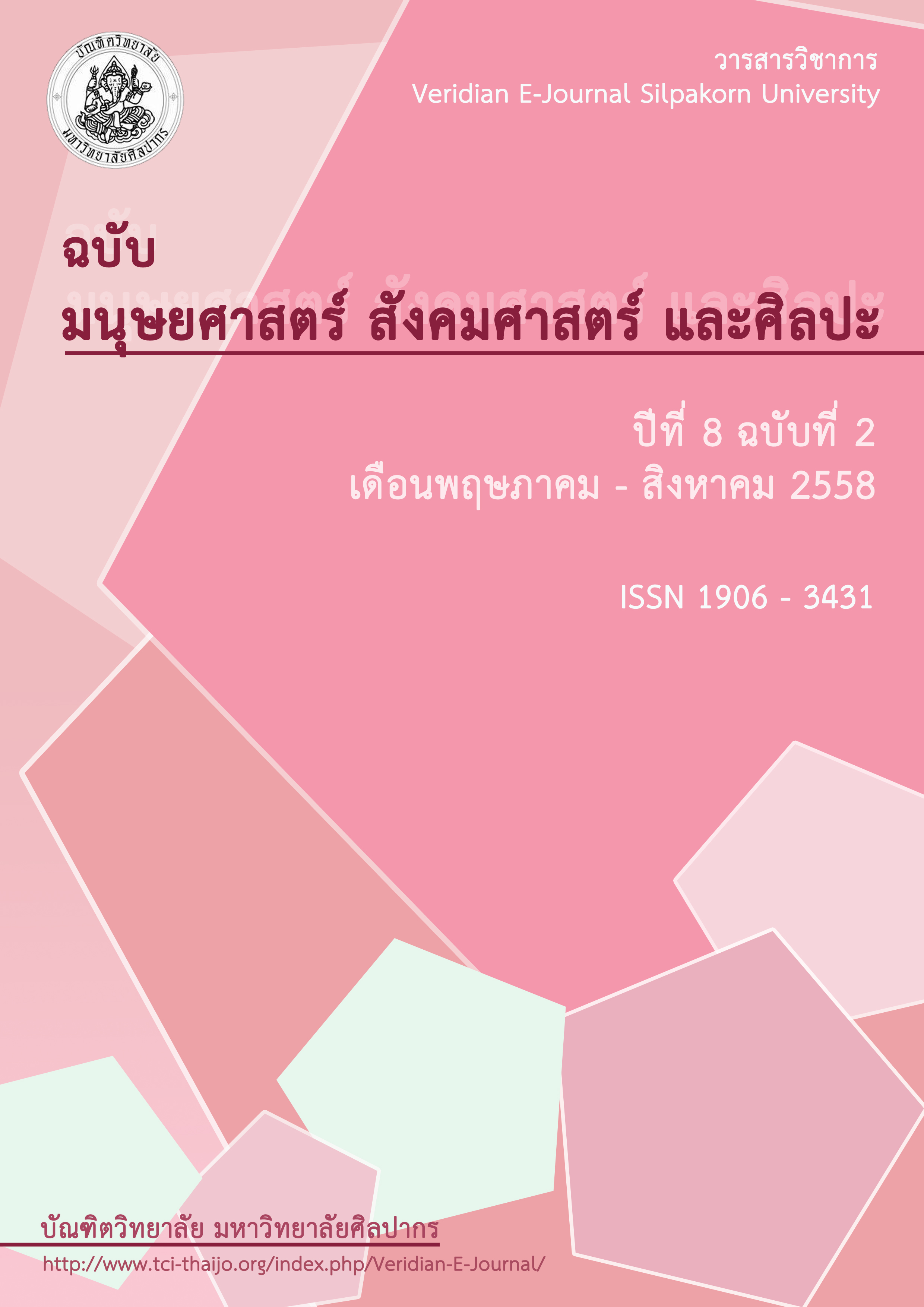การพัฒนาหลักสูตรงานประดิษฐ์ผลิตภัณฑ์จากผ้าทอคูบัวตามแนวคิดเศรษฐกิจสร้างสรรค์ สำหรับชั้นมัธยมศึกษาปีที่ 1
Main Article Content
Abstract
บทคัดย่อ
การวิจัยครั้งนี้มีจุดประสงค์เพื่อ (1) เพื่อศึกษาข้อมูลพื้นฐานในการพัฒนาหลักสูตรงานประดิษฐ์ผลิตภัณฑ์จากผ้าทอคูบัวตามแนวเศรษฐกิจสร้างสรรค์ สำหรับนักเรียนชั้นมัธยมศึกษาปีที่ 1 (2) เพื่อพัฒนาหลักสูตรงานประดิษฐ์ผลิตภัณฑ์จากผ้าทอคูบัวตามแนวเศรษฐกิจสร้างสรรค์ สำหรับนักเรียนชั้นมัธยมศึกษาปีที่ 1 (3) เพื่อทดลองใช้หลักสูตรงานประดิษฐ์ผลิตภัณฑ์จากผ้าทอคูบัวตามแนวเศรษฐกิจสร้างสรรค์ สำหรับนักเรียนชั้นมัธยมศึกษาปีที่ 1 และ (4) เพื่อประเมินและปรับปรุงหลักสูตรงานประดิษฐ์ผลิตภัณฑ์จากผ้าทอคูบัวตามแนวเศรษฐกิจสร้างสรรค์เฉพาะประเด็นเกี่ยวกับผลการเรียนรู้ ความสามารถในการทำโครงงานงานประดิษฐ์จากผ้าทอคูบัวตามแนวเศรษฐกิจสร้างสรรค์ และประเมินความคิดเห็นของนักเรียนที่มีต่อหลักสูตรงานประดิษฐ์ผลิตภัณฑ์จากผ้าทอคูบัวตามแนวเศรษฐกิจสร้างสรรค์ กลุ่มตัวอย่าง คือ นักเรียนชั้นมัธยมศึกษาปีที่ 1 จำนวน 24 คน จากโรงเรียนบรมราชินีนาถราชวิทยาลัย จังหวัดราชบุรี การทดลองใช้หลักสูตรในภาคเรียนที่ 1 ปีการศึกษา 2557 ระยะเวลาที่ใช้ในการทดลอง จำนวน 20 ชั่วโมง แบบแผนการวิจัยเป็นแบบ One Group Pretest-Posttest Design เครื่องมือที่ใช้ในการวิจัย ประกอบด้วย (1) แบบทดสอบวัดผลการเรียนรู้ (2) แบบประเมินการทำโครงงานงานประดิษฐ์จากผ้าทอคูบัว (3) แบบประเมินผลิตภัณฑ์สร้างสรรค์ (4) แบบสอบถามความคิดเห็นของนักเรียนที่มีต่อหลักสูตร การวิเคราะห์ข้อมูลใช้สถิติ ค่าเฉลี่ย () ค่าส่วนเบี่ยงเบนมาตรฐาน (S.D.) ค่า t-test แบบ Dependent และการวิเคราะห์เนื้อหา (Content Analysis)
ผลการวิจัยพบว่า (1) นักเรียนเห็นความสำคัญให้พัฒนาหลักสูตรงานประดิษฐ์ผลิตภัณฑ์จากผ้าทอคูบัวตามแนวเศรษฐกิจสร้างสรรค์ เพราะนักเรียนได้เรียนรู้เกี่ยวผลิตภัณฑ์ในท้องถิ่น และเกิดจิตสำนึกในการรักและหวงแหนของที่มีอยู่ในท้องถิ่นตนเอง มีความสามารถในการทำโครงงานงานประดิษฐ์ สามารถนำความรู้ไปประยุกต์ใช้ในชีวิตประจำวันและสร้างอาชีพได้ โดยมีครูผู้สอนและผู้รู้ในท้องถิ่นเข้าร่วมจัดกิจกรรมการเรียนรู้และประเมินผล (2) หลักสูตรงานประดิษฐ์ผลิตภัณฑ์จากผ้าทอคูบัวตามแนวเศรษฐกิจสร้างสรรค์ มีเป้าหมาย (2.1) ให้นักเรียนรู้และเข้าใจหลักการ ทักษะพื้นฐานในการประดิษฐ์ผลิตภัณฑ์งานประดิษฐ์ มีสมรรถนะด้านความคิดสร้างสรรค์ (2.2) มีคุณลักษณะอันพึงประสงค์และมีเจคติที่ดีต่อการประกอบอาชีพ (2.3) ได้ศึกษาเนื้อหาเกี่ยวกับประวัติความเป็นมาของผ้าทอคูบัว ขั้นตอนการทำโครงงานงงานประดิษฐ์ (2.4) โดยจัดกิจกรรมการเรียนรู้แบบวิธีสอนแบบโครงงาน โดยมีแผนการจัดการเรียนรู้ หน่วยการเรียนรู้ที่ 6 เรื่องงานประดิษฐ์จากผ้าทอคูบัว จำนวน 4 แผน (2.6) หลักสูตรมีความเหมาะสมและสอดคล้อง โดยมีค่าดัชนีความสอดคล้อง (IOC) อยู่ระหว่าง 0.67-1.00 (3) หลักสูตรงานประดิษฐ์ผลิตภัณฑ์จากผ้าทอคูบัวตามแนวเศรษฐกิจสร้างสรรค์สำหรับนักเรียนชั้นมัธยมศึกษาปีที่ 1 ผู้วิจัยได้นำหลักสูตรไปทดลองใช้กับนักเรียนชั้นมัธยมศึกษาปีที่ 1 โรงเรียนบรมราชินีนาถราชวิทยาลัย ภาคเรียนที่ 1 ปีการศึกษา 2557 จำนวน 24 คน ใช้เวลา 20 ชั่วโมง โดยผู้วิจัยจัดการเรียนแบบโครงงาน ศึกษาข้อมูลเกี่ยวกับผ้าทอคูบัว โดยการนำนักเรียนไปศึกษานอกสถานที่ สืบค้นทางอินเตอร์เน็ต เก็บรวบรวมข้อมูล ร่วมกันอภิปราย ให้นักเรียนทำโครงงานประดิษฐ์ตามความสนใจ พบว่านักเรียนมีความตั้งใจรับผิดชอบ และร่วมกันทำโครงงาน (1) ผลการเรียนรู้ของนักเรียนเรื่องประวัติและความเป็นมาของผ้าทอคูบัว หลังการใช้หลักสูตรสูงกว่าก่อนการใช้หลักสูตรอย่างมีนัยสำคัญทางสถิติที่ระดับ0.05 (2) นักเรียนมีความสามารถในการทำโครงงานงานประดิษฐ์ผลิตภัณฑ์จากผ้าทอคูบัวอยู่ในระดับดี (3) ผลิตภัณฑ์สร้างสรรค์จากผ้าทอคูบัวของนักเรียน โดยภาพรวมอยู่ในระดับดี (4) ความคิดเห็นของนักเรียนที่มีต่อหลักสูตร ด้านที่นักเรียนมีความเห็นอยู่ในระดับมากที่สุด คือ ด้านการวัดและประเมินผล โดยครูผู้สอนใช้การวัดผลและประเมินผลด้วยการปฏิบัติ และใช้สถานที่จริงในชุนชนเป็นแหล่งเรียนรู้
คำสำคัญ : การพัฒนาหลักสูตร/โครงงานประดิษฐ์/เศรษฐกิจสร้างสรรค์
Abstract
The purpose of this research were1) to study the basic information in The handicraft curriculum development of Kubua woven frabric along the creative economy for seven grade students. 2) to develop The handicraft curriculum development of Kubua woven frabric along the creative economy for Grade 7 students. 3) to implement The handicraft curriculum development on Kubua woven frabric along the creative economy for Grade 7 students. And 4) to evaluate and improve The handicraft curriculum development of Kubua woven frabric along the creative economy for Grade 7 students. The ability to create products made from woven Kubua frabric. And the opinions of the students on the course craft products from woven khubua along the creative economy.
The sample group consisted of 24 Grade 7 students of Queen's college school, Ratchaburi Province.The experiments were 20 hours.The pattern research One Group Pretest-Posttest Design.The research instruments used in this study included 1) The handicraftcurriculum development of Kubua woven frabric along the creative economy for Grade 7 students 2)the learning outcomes test 2) assessment of project work made from woven Kubua 3). Assessment of product creative 4) questionnaire about students’ opinions towards the implementation of the curriculum.The data were Analysed using percentage,mean , standard deviation, the t-test Dependent and content analysis
The results of this research were:
1. The students and involved persons realized and preferred the need toThe handicraft curriculum development of Kubua woven frabric along the creative economy for Grade 7 students. Students learn about local products. The responsibility of love and cherish are available .Have the ability to do the project artificial.Can lead to knowledge application in their daily lifeThe teachers who participate and local learning activities and evaluation.
2. The handicraft curriculum development of Kubua woven frabric along the creative economy for Grade 7 students. Target students to know and understand the principle. Basic skills in the invention of artificial products Have competency in creativity. Desirable traits and have a good attitude towards career. The content about the history of woven fabric kubua. The process of doing project work is artificial. By learning activities the project method lesson plans, the unit that 6 work fabricated from woven kubua. The 4 plan course is appropriate and consistent. The consistency index (IOC) between the 0.67-1.00.
3. The handicraft curriculum development of Kubua woven frabric along the creative economy for Grade 7 students implemented with the 24 Grade 7 students of Queen's college for 20 hours take by the project-based learning Study on woven fabric kubua. The students study outside the search on the Internet. Data were collected together to debate the students to do the project constructed according to their interest. It was found that the students with the intention of responsible and do the project.
4. The students’ learning outcomes about the history and background of woven fabric kubua after the implementation of the experimental curriculum at significantly 0.05 level.The students’ ability to do the project artificial product of woven fabric kubua at a good level. Creative products woven Kubua of students overall at the good level. The opinions of students towards the curriculum. The students' opinions at the highest level's measurement and evaluation. The method used in measurement and evaluation in practice. And use the real place in Chun as a learning resource.
Keywords : Curriculum development / Project artificial / creative economy.
